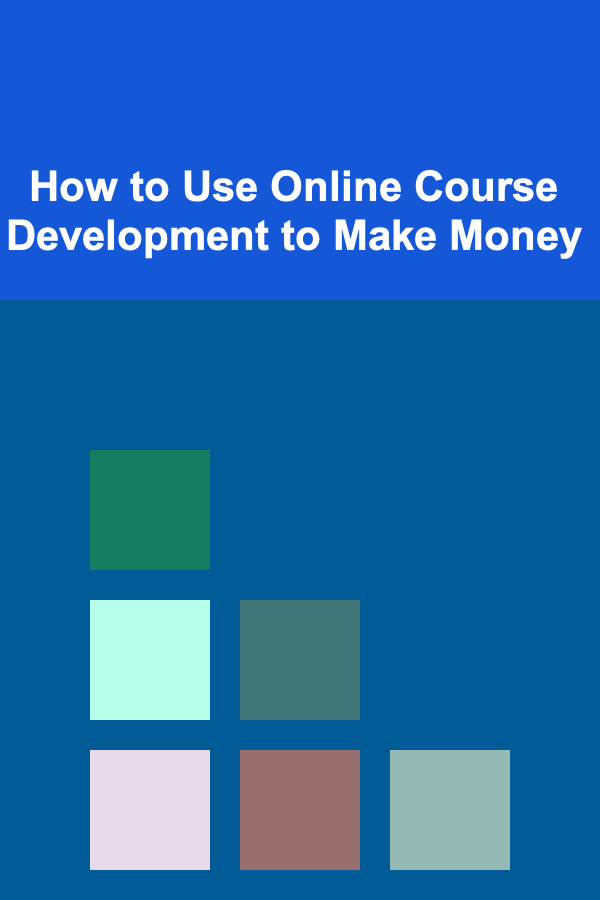
How to Use Online Course Development to Make Money
ebook include PDF & Audio bundle (Micro Guide)
$12.99$10.99
Limited Time Offer! Order within the next:

The world has witnessed a massive transformation in education with the rise of online learning. Once limited to traditional classrooms, education is now accessible to millions of people across the globe, often through the convenience of online courses. This shift in how education is delivered has created a powerful opportunity for content creators, experts, and entrepreneurs to monetize their knowledge and skills by developing and selling online courses. In this article, we will delve into the potential of online course development, exploring the steps, strategies, and opportunities involved in turning expertise into a profitable venture.
The Explosive Growth of Online Learning
In recent years, the online learning industry has seen unprecedented growth. According to the Global Market Insights report, the eLearning market was valued at approximately $200 billion in 2019, and it is projected to reach over $370 billion by 2026. This growth has been spurred by several factors, including the increasing adoption of digital technologies, the desire for self-paced learning, and the increasing need for affordable and flexible education options.
This explosion of demand presents a unique opportunity for anyone with valuable knowledge or skills to create an online course and turn it into a revenue-generating asset. Whether you are an expert in programming, graphic design, language learning, marketing, fitness, or even niche topics like personal finance or gardening, there is a vast market of learners eager to access your expertise.
Why Online Courses Are a Great Source of Income
Before diving into the steps of course creation, let's take a moment to understand why developing online courses is a viable way to make money.
1. Low Startup Costs
One of the most attractive aspects of online course development is the relatively low cost of entry. Unlike traditional businesses that require physical inventory, office space, or employees, creating an online course primarily requires time, knowledge, and a few basic tools such as a camera, microphone, and a computer. Platforms like Teachable, Udemy, and Skillshare offer affordable, user-friendly course creation tools that make it easy to get started.
2. Scalable Income Potential
Unlike offering personal services or consulting, an online course can be sold to an unlimited number of students, meaning there is no ceiling on your potential income. Once a course is created and uploaded, it can be sold repeatedly without significant additional work, making it a highly scalable source of income.
3. Passive Income
One of the key advantages of online courses is the potential for passive income. After the initial effort of creating the course, it can continue to generate revenue for you while you sleep, travel, or focus on other projects. This is especially appealing to people who want to diversify their income streams without continuously trading time for money.
4. Global Reach
Online courses can be accessed by anyone with an internet connection, which means you are not limited to a specific geographic location or audience. This global reach opens up new revenue opportunities, as you can target students in different countries, cultures, and time zones.
5. Authority Building and Brand Recognition
Creating and selling online courses not only generates income but also establishes you as an authority in your field. By sharing your knowledge, you can build credibility, increase visibility, and position yourself as a go-to expert. This can lead to additional opportunities such as speaking engagements, consulting, book deals, or other ventures that complement your course business.
The Steps to Creating and Selling an Online Course
Creating a profitable online course involves a series of steps, from ideation and planning to marketing and monetization. Below are the key stages involved in creating a course that can generate income.
1. Identify Your Niche and Target Audience
The first step in developing a successful online course is identifying a niche in which you are an expert and that has a market demand. When choosing a topic, consider the following:
- What are you passionate about? The best courses are created by people who are not only knowledgeable but also passionate about the subject matter. Your enthusiasm will be reflected in the quality of the course.
- What are people searching for? Conduct market research to identify the pain points or challenges that your target audience is facing. Platforms like Google Trends, Udemy, and Quora can help you gauge the demand for your course topic.
- Is there existing competition? While competition can indicate that there is a market, you should also aim to differentiate your course. Think about what unique perspective, format, or experience you can offer that other courses don't.
By selecting a niche that aligns with your expertise and market demand, you will lay the groundwork for a successful course.
2. Define the Learning Outcomes
Once you've settled on a topic, the next step is to define the learning outcomes of your course. These outcomes will help guide the structure of the course and give your students a clear understanding of what they can expect to learn.
- What skills will students gain?
- How will the course improve their life or work?
- What practical applications will the content cover?
By articulating clear and measurable learning outcomes, you provide your students with the motivation to enroll in the course and follow through to completion.
3. Create the Course Content
The content creation phase is where you will transform your knowledge into a structured learning experience. Depending on the type of course you want to create, your content can take various formats, such as:
- Video lessons: Video is the most popular and engaging format for online courses. High-quality videos that explain concepts, demonstrate techniques, or provide case studies can significantly enhance the learning experience.
- Written materials: Course guides, PDFs, and articles provide supplementary content that students can refer to at their own pace.
- Interactive elements: Quizzes, assignments, and discussion forums encourage engagement and help reinforce learning.
- Live sessions: Offering live Q&A sessions or group coaching can help build community and provide students with direct access to you as an instructor.
When creating your course, be sure to break down complex topics into manageable sections. Structure your lessons in a logical order, and ensure that your content is easily digestible.
4. Choose a Platform to Host and Sell Your Course
Once your course content is ready, you need to choose a platform to host and sell it. There are many course hosting platforms available, each with its own features, fees, and benefits. Some popular options include:
- Teachable: An easy-to-use platform that allows you to create and sell online courses, with customizable branding options and a variety of pricing models.
- Udemy: A large marketplace with a built-in audience, which is perfect for course creators who want to tap into an existing pool of students. However, Udemy takes a percentage of course sales.
- Thinkific: Another popular platform for course creators, offering robust features such as customizable websites and integrated marketing tools.
Alternatively, you could choose to host the course on your own website, using tools like WordPress combined with plugins like LearnDash or LifterLMS. While this requires more effort to set up, it offers more control over pricing, branding, and customer data.
5. Set the Right Price
Pricing is a crucial factor in the success of your online course. While it can be tempting to price your course high, especially if you're an expert, it's important to consider the following:
- Market rates: Look at similar courses in your niche and find out what others are charging. This will help you position your course competitively.
- Value proposition: Ensure that the price reflects the value you are offering. If your course provides significant value or teaches a high-demand skill, you may be able to price it higher.
- Pricing model: You can offer different pricing models, such as one-time payment, subscription-based access, or payment plans. Each model has its advantages, depending on your target audience.
Experiment with different pricing strategies, and be open to adjusting your price as you gather feedback from students.
6. Market Your Online Course
Creating a course is just the beginning. To make money, you need to market your course effectively. Here are some marketing strategies to consider:
- Social media promotion: Leverage platforms like Facebook, Instagram, LinkedIn, and Twitter to promote your course and engage with your audience.
- Email marketing: Build an email list and send out promotional emails with special offers, discounts, or content previews.
- Content marketing: Write blog posts, create videos, or host webinars to attract potential students and showcase your expertise.
- Affiliate marketing: Partner with other influencers or marketers who can promote your course for a commission on sales.
The key to successful marketing is to target the right audience and to offer value through free content or resources. By building relationships with your audience, you'll increase the likelihood of converting them into paying students.
7. Gather Feedback and Improve Your Course
Once your course is live, it's essential to gather feedback from your students to understand what worked well and what can be improved. Use surveys, reviews, and direct communication to learn about the student experience.
By continuously improving your course based on feedback, you can enhance its value, attract more students, and keep existing students satisfied.
Scaling Your Online Course Business
Once you've created and successfully launched one course, the next step is to scale your online course business. Here are a few strategies to consider:
- Create additional courses: If your first course was successful, you can expand your offerings by creating related courses or exploring new niches.
- Offer coaching or consulting: If your course covers a specialized topic, you can offer one-on-one coaching or group consulting to generate additional income.
- Licensing and bulk sales: Some companies or educational institutions may be interested in purchasing licenses for your course, especially if it's relevant to their employees or students.
As you scale, it's important to keep focusing on providing value and maintaining the quality of your courses. A good reputation will be your greatest asset in the long run.
Conclusion
Developing online courses offers a unique opportunity to turn your knowledge and expertise into a profitable business. By creating high-quality content, marketing it effectively, and continuously improving based on feedback, you can build a sustainable income stream that leverages your skills and knowledge. Whether you're looking for passive income, a side hustle, or a full-time business, online course development can provide a flexible and scalable path to financial success. With the right strategies in place, you can tap into the growing demand for online education and turn your passion into profit.

How to Plan a Game Night with Fun and Engaging Activities at Home
Read More
How To Understand Security Information and Event Management (SIEM)
Read More
How to Promote Environmental Awareness in Children
Read More
Mastering the Art of High-Reach Cleaning with Extendable Poles
Read More
How to Master Ballet Turns: A Beginner's Guide
Read More
10 Tips for Perfect Milk Steaming Every Time
Read MoreOther Products

How to Plan a Game Night with Fun and Engaging Activities at Home
Read More
How To Understand Security Information and Event Management (SIEM)
Read More
How to Promote Environmental Awareness in Children
Read More
Mastering the Art of High-Reach Cleaning with Extendable Poles
Read More
How to Master Ballet Turns: A Beginner's Guide
Read More